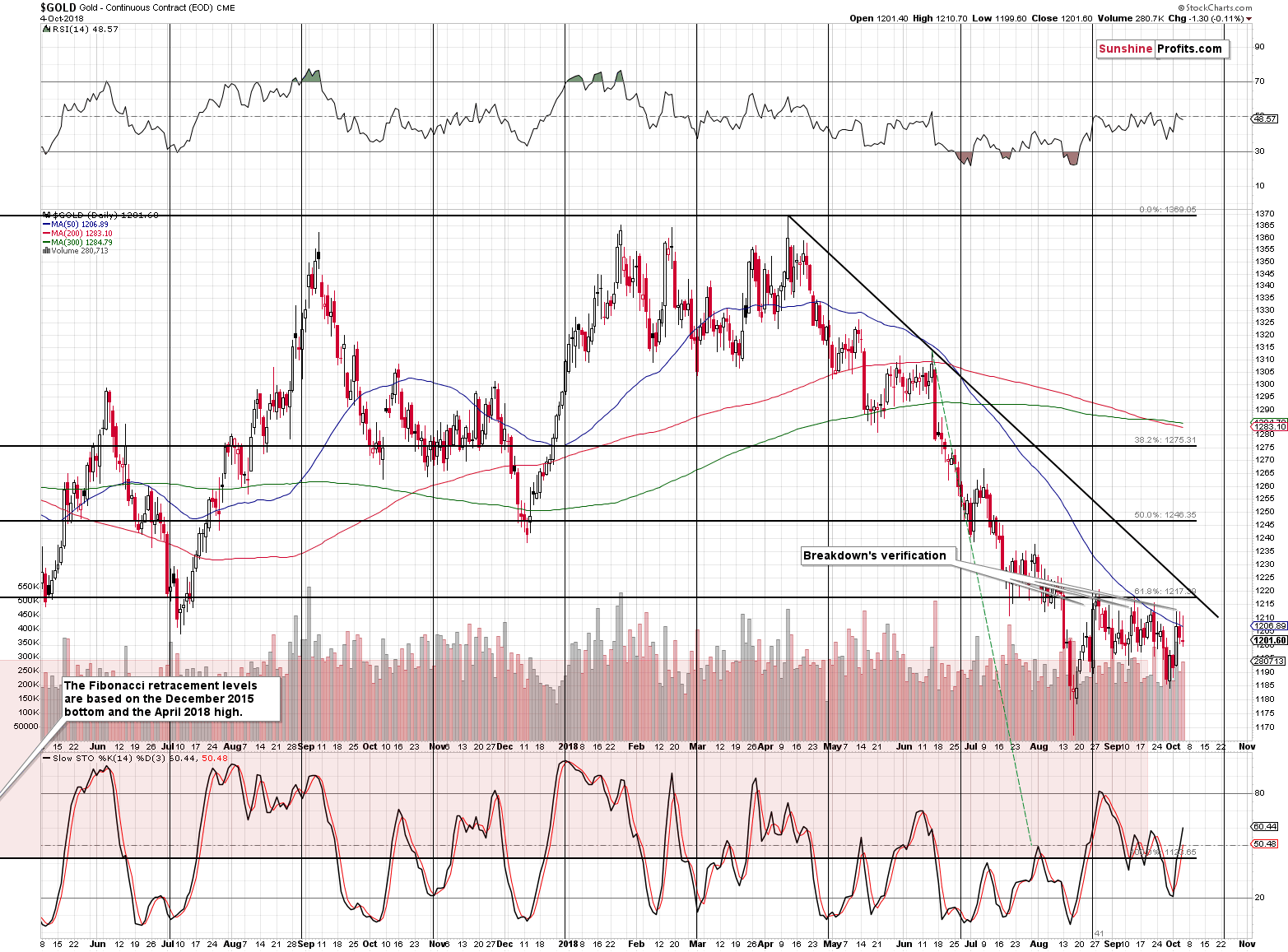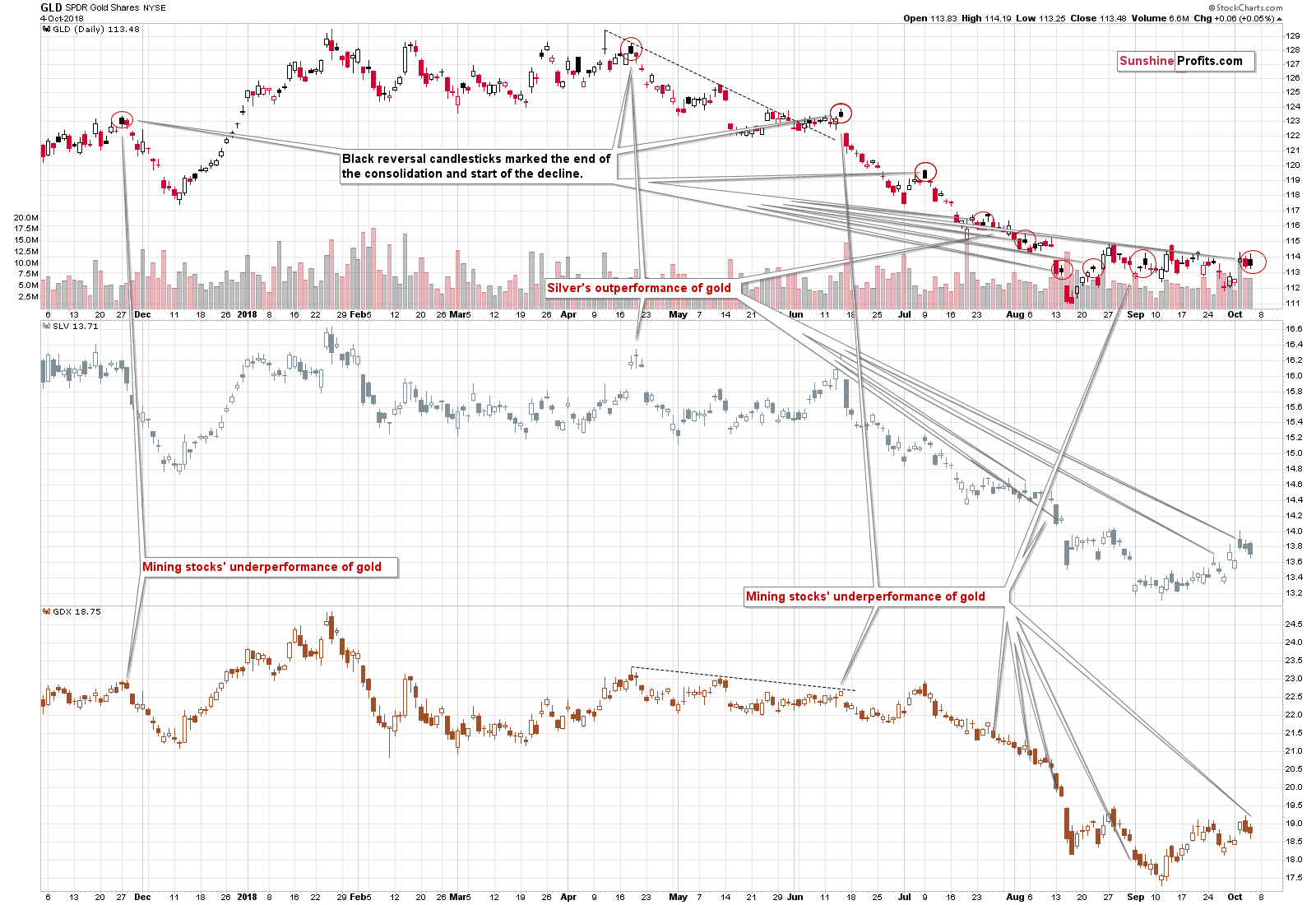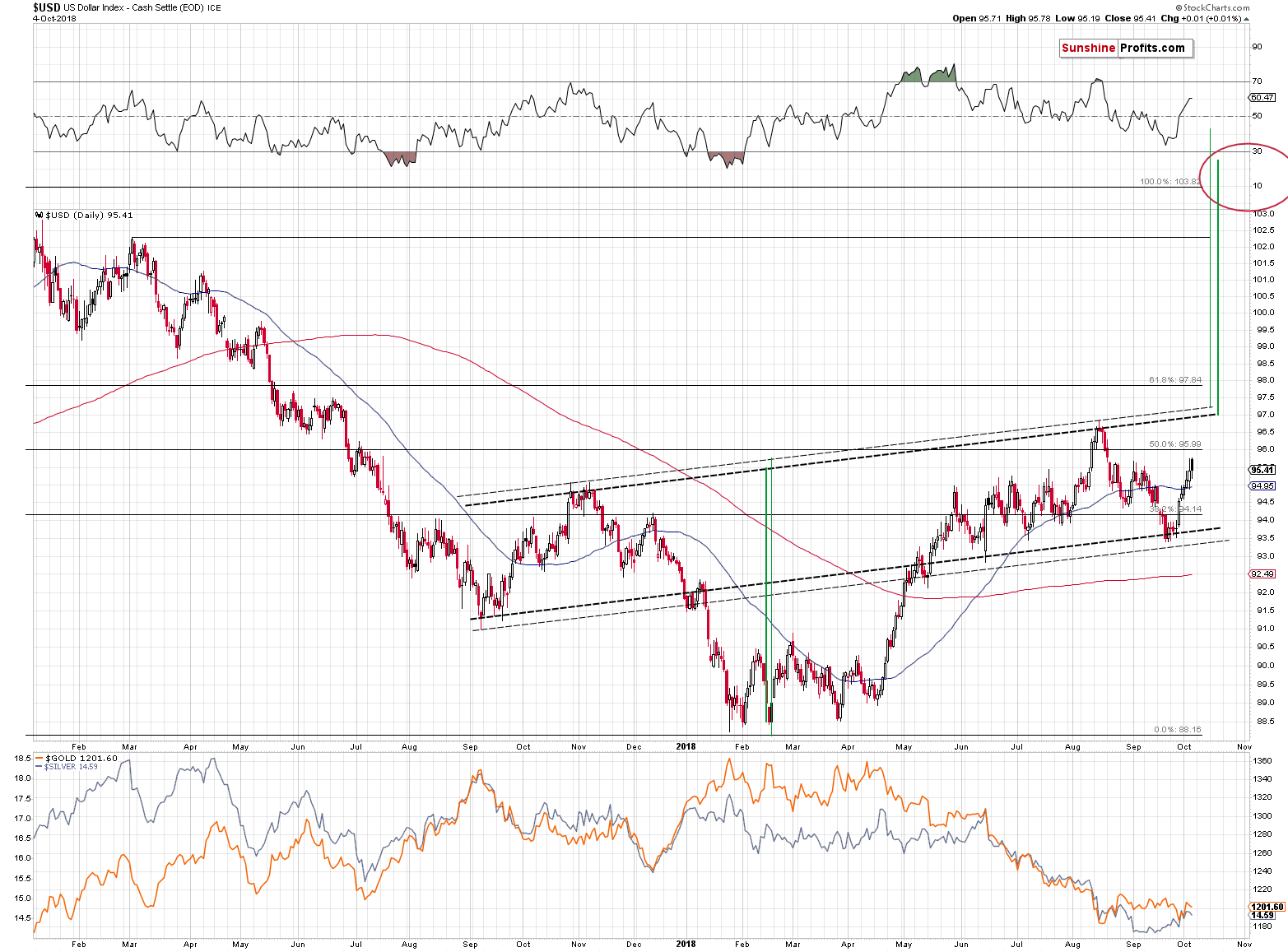Briefly: in our opinion, full (250% of the regular size of the position) speculative short positions in gold, silver and mining stocks are justified from the risk/reward perspective at the moment of publishing this alert.
When we wrote yesterday’s Gold & Silver Trading Alert, we saw gold moving a few dollars above the levels at which it had been trading 24 hours before. But the rally was reversed and gold ended the session $1.30 lower. That’s yet another intraday high in a row that’s followed by an afternoon decline. What does it tell us?
Let’s take a look at the gold chart for details (charts courtesy of http://stockcharts.com/).

It tells us that the price of gold doesn’t really want to move higher from here. There are attempts, but each of them fails as buyers are overwhelmed by the selling pressure. And the tiny details confirm the bearish outlook. In the past 3 days, the closing prices were lower each day and we can say the same thing about the levels that the price reached intraday.

In case of the GLD ETF, we saw a tiny daily price increase ($0.06) that was preceded by a visible intraday decline. The Stockcharts charting platform marks such sessions with black. Yesterday’s black candlestick is clearly visible and since we have previously seen similar developments right before short-term declines, the implications are bearish.

Meanwhile, the USD Index moved back and forth and ultimately ended yesterday’s session relatively unchanged. The pause appears to be something normal given the size of the preceding short-term rally.
But, one may wonder if there are bullish implications of the fact that gold and silver didn’t decline in the last several days, even though the USDX moved higher. For now it still appears that the reaction could be delayed, just like it was in May and June. It may become a bullish factor for the PMs, if this phenomenon persists. If.
Not much happened in other precious-metals-related charts and not much is happening in today’s pre-market trading, so today’s Alert is relatively short. But please don’t be fooled by the seemingly calm nature of the situation. It was exactly that – nothing – what directly preceded the big slide in April 2013.
The April 2013 Decline - Trigger
Back then there was a direct trigger in the form of Goldman Sachs’s suggesting to short gold and then quite a few other explanations were offered, but the reality is that nobody can say with 100% certainty what triggered the move. And, no, manipulation is not the answer to everything, because whatever manipulation attempt would have been made, the market forces would have put the price back at the equilibrium shortly. It’s been years and gold is not back above $1,500. Surely, the decline could have been triggered by some powerful entity, but it was the fact that the market was ready to decline that made all the difference. The powerful entity might try the same thing – triggering a decline – in a different state of the market, but the results would be entirely different. The initial breakdown would be followed by its invalidation and a powerful rally.
The point is that it was not the trigger that was important. It was the state of the market that made the huge decline possible. And the state of the market is currently that - it’s ready for a major price slide. The trigger may come from anything, it could even be something irrelevant. There are many economic indicators published each day and each of them could trigger a certain move. Why are some of them mostly ignored by the market, while others are generating powerful price moves? The market is ready for some of them and not for the others. By applying the technical analysis to the charts, we can detect the state of the market and be prepared for the move when it finally comes.
Those who are not familiar with the technical tools will say that we were just lucky and that the price move was caused by something else. But this voodoo really works – it detects the state of the market and once that is determined, the trigger (the only thing that’s visible to those who are not familiar with the technical analysis) is no longer that important.
Important Analyses
Before summarizing, we would like to emphasize that we have recently posted several analyses that are very important and that one should keep in mind, especially in the next several weeks. If you haven’t had the chance of reading them previously, we encourage you to do so today:
- Dear Gold Investor - Letters from 2013 - Analogy to 2013, which should make it easier to trade the upcoming sizable upswing (if enough factors point to it, that is) and to enter the market close to the final bottom.
- Gold to Soar Above $6,000 - discussion of gold’s long-term upside target of $6,000.
- Preparing for THE Bottom in Gold: Part 6 – What to Buy - extremely important analysis of the portfolio structure for the next huge, multi-year rally in the precious metals.
- Preparing for THE Bottom in Gold: Part 7 – Buy-and-hold on Steroids - description of a strategy dedicated to significantly boosting one’s long-term investment returns while staying invested in the PM sector.
- Gold’s Downside Target, Upcoming Rebound, and Miners’ Buy Plan - details regarding the shape of the following price moves, a buying plan for mining stocks, and a brief discussion of the final price targets for the current decline.
- Gold: What Happened vs. What Changed - discussion of the latest extreme readings from gold’s CoT report
- Key Factors for Gold & Silver Investors - discussion of key, long-term factors that support the bearish outlook for PMs. We are often asked what makes us so bearish – this article is a reply to this question.
- The Upcoming Silver Surprise - two sets of price targets for gold, silver and mining stocks: the initial and the final one.
- Precious Metals Sector: It’s 2013 All Over Again - comparison between 2013 and 2018 throughout the precious metals sector, the general stock market and the USD Index. Multiple similarities point to the repeat of a 2013-style volatile decline in the PMs.
Summary
Summing up, the outlook for the precious metals sector remains extremely bearish even though not much seems to have happened yesterday. It’s important to keep in mind the fact that it was precisely “nothing” that directly preceded the two-day $200+ decline in gold in April, 2013. Consequently, just because nothing changed yesterday, it doesn’t mean that nothing is about to. All in all, it seems that the huge profits on our short positions will soon become enormous.
As always, we’ll keep you – our subscribers – informed.
To summarize:
Trading capital (supplementary part of the portfolio; our opinion): Full short positions (250% of the full position) in gold, silver and mining stocks are justified from the risk/reward perspective with the following stop-loss orders and exit profit-take price levels:
- Gold: profit-take exit price: $1,062; stop-loss: $1,226; initial target price for the DGLD ETN: $82.96; stop-loss for the DGLD ETN $53.67
- Silver: profit-take exit price: $12.72; stop-loss: $15.16; initial target price for the DSLV ETN: $46.97; stop-loss for the DSLV ETN $31.37
- Mining stocks (price levels for the GDX ETF): profit-take exit price: $13.12; stop-loss: $19.61; initial target price for the DUST ETF: $80.97; stop-loss for the DUST ETF $33.37
Note: the above is a specific preparation for a possible sudden price drop, it does not reflect the most likely outcome. You will find a more detailed explanation in our August 1 Alert. In case one wants to bet on junior mining stocks’ prices (we do not suggest doing so – we think senior mining stocks are more predictable in the case of short-term trades – if one wants to do it anyway, we provide the details), here are the stop-loss details and target prices:
- GDXJ ETF: profit-take exit price: $17.52; stop-loss: $29.43
- JDST ETF: initial target price: $154.97 stop-loss: $64.88
Long-term capital (core part of the portfolio; our opinion): No positions (in other words: cash)
Insurance capital (core part of the portfolio; our opinion): Full position
Important Details for New Subscribers
Whether you already subscribed or not, we encourage you to find out how to make the most of our alerts and read our replies to the most common alert-and-gold-trading-related-questions.
Please note that the in the trading section we describe the situation for the day that the alert is posted. In other words, it we are writing about a speculative position, it means that it is up-to-date on the day it was posted. We are also featuring the initial target prices, so that you can decide whether keeping a position on a given day is something that is in tune with your approach (some moves are too small for medium-term traders and some might appear too big for day-traders).
Plus, you might want to read why our stop-loss orders are usually relatively far from the current price.
Please note that a full position doesn’t mean using all of the capital for a given trade. You will find details on our thoughts on gold portfolio structuring in the Key Insights section on our website.
As a reminder – “initial target price” means exactly that – an “initial” one, it’s not a price level at which we suggest closing positions. If this becomes the case (like it did in the previous trade) we will refer to these levels as levels of exit orders (exactly as we’ve done previously). Stop-loss levels, however, are naturally not “initial”, but something that, in our opinion, might be entered as an order.
Since it is impossible to synchronize target prices and stop-loss levels for all the ETFs and ETNs with the main markets that we provide these levels for (gold, silver and mining stocks – the GDX ETF), the stop-loss levels and target prices for other ETNs and ETF (among other: UGLD, DGLD, USLV, DSLV, NUGT, DUST, JNUG, JDST) are provided as supplementary, and not as “final”. This means that if a stop-loss or a target level is reached for any of the “additional instruments” (DGLD for instance), but not for the “main instrument” (gold in this case), we will view positions in both gold and DGLD as still open and the stop-loss for DGLD would have to be moved lower. On the other hand, if gold moves to a stop-loss level but DGLD doesn’t, then we will view both positions (in gold and DGLD) as closed. In other words, since it’s not possible to be 100% certain that each related instrument moves to a given level when the underlying instrument does, we can’t provide levels that would be binding. The levels that we do provide are our best estimate of the levels that will correspond to the levels in the underlying assets, but it will be the underlying assets that one will need to focus on regarding the signs pointing to closing a given position or keeping it open. We might adjust the levels in the “additional instruments” without adjusting the levels in the “main instruments”, which will simply mean that we have improved our estimation of these levels, not that we changed our outlook on the markets. We are already working on a tool that would update these levels on a daily basis for the most popular ETFs, ETNs and individual mining stocks.
Our preferred ways to invest in and to trade gold along with the reasoning can be found in the how to buy gold section. Additionally, our preferred ETFs and ETNs can be found in our Gold & Silver ETF Ranking.
As a reminder, Gold & Silver Trading Alerts are posted before or on each trading day (we usually post them before the opening bell, but we don't promise doing that each day). If there's anything urgent, we will send you an additional small alert before posting the main one.
=====
Latest Free Trading Alerts:
“Mr. Gold, you have disappointed us! But, really, you dropped almost four percent in the third quarter of this year.” This is what many analysts could say. But we warned our Readers against being bullish in the current macroeconomic environment. We invite you to read our today’s article about the gold market in Q3 2018 and find out what happened – and what are the implications for the end of the year.
=====
Thank you.
Sincerely,
Przemyslaw Radomski, CFA
Founder, Editor-in-chief, Gold & Silver Fund Manager
Gold & Silver Trading Alerts
Forex Trading Alerts
Oil Investment Updates
Oil Trading Alerts



